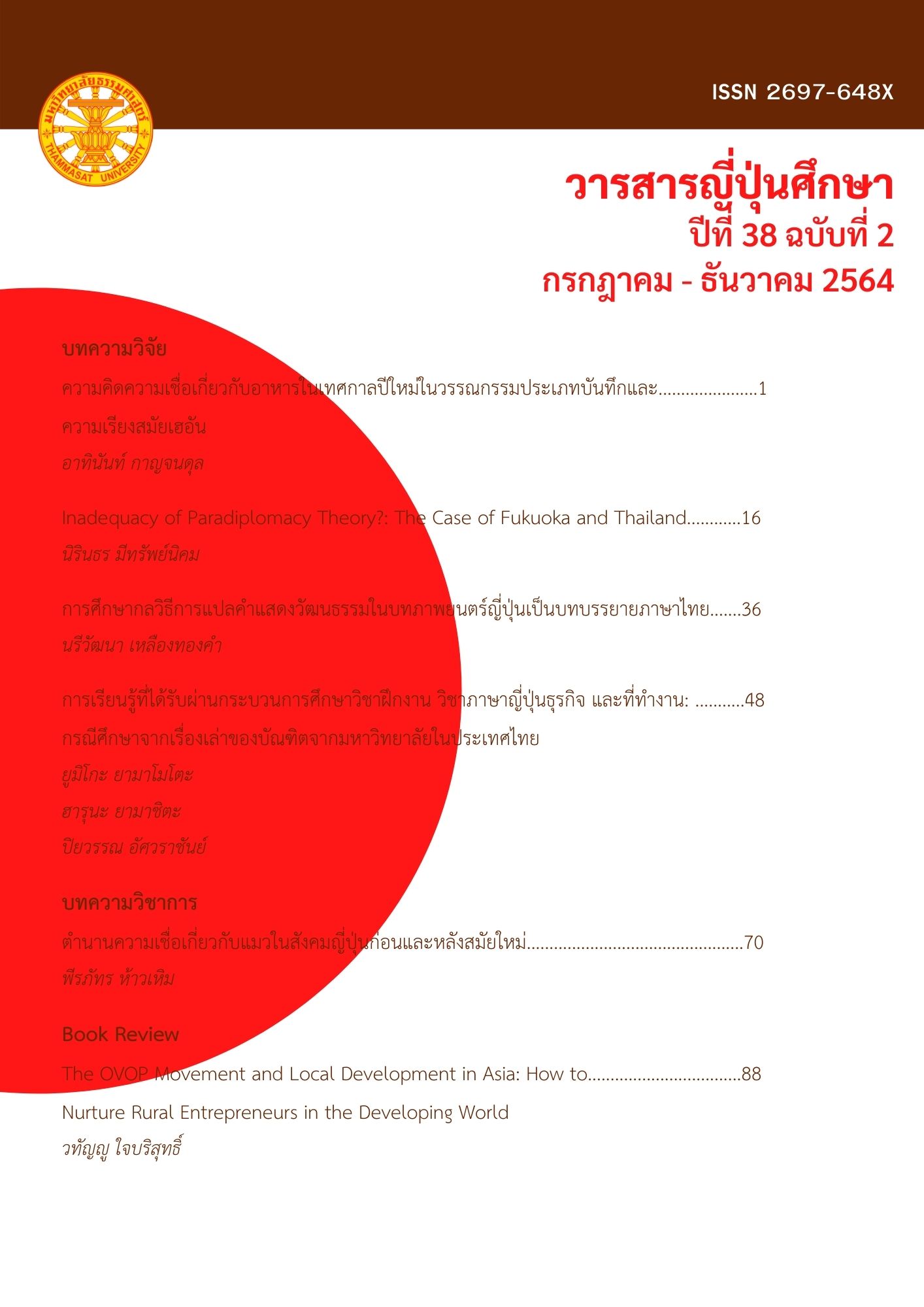การศึกษากลวิธีการแปลคำแสดงวัฒนธรรมในบทภาพยนตร์ญี่ปุ่นเป็นบทบรรยายภาษาไทย
คำสำคัญ:
การแปล, คำแสดงวัฒนธรรม, บทบรรยายไทย, ภาพยนตร์ญี่ปุ่น, Mirai no Miraiบทคัดย่อ
บทความนี้มีวัตถุประสงค์เพื่อศึกษากลวิธีการแปลคำแสดงวัฒนธรรมในบทภาพยนตร์ญี่ปุ่นเป็นบทบรรยายภาษาไทย และเพื่อศึกษาทิศทางการแปลคำแสดงวัฒนธรรมในบทภาพยนตร์ญี่ปุ่นเป็นบทบรรยายภาษาไทย โดยมีกรณีศึกษาการแปลจากภาพยนตร์แอนิเมชันญี่ปุ่นเรื่อง Mirai no Mirai (未来のミライ) ผลการศึกษาพบว่า ในเรื่องพบการใช้และแปลคำแสดงวัฒนธรรมจากบทภาพยนตร์ภาษาญี่ปุ่นเป็นบทบรรยายภาษาไทยรวมจำนวน 150 ประโยค โดยมีการเลือกใช้กลวิธีการแปลแบบ Omission มากที่สุดจำนวน 76 ประโยค และเมื่อดูจากภาพรวมของการแปลคำแสดงวัฒนธรรมเป็นบทบรรยายไทยทั้งหมดจะสามารถวิเคราะห์ได้ว่า ปัจจัยที่ส่งผลต่อการเลือกใช้กลวิธีการแปลมีหลายประการดังนี้ 1) บริบทต่าง ๆ ที่ปรากฏในภาพยนตร์ เช่น ภาพ สถานการณ์ ลำดับการปรากฏของคำแสดงวัฒนธรรม 2) ผู้สนทนาและคู่สนทนา 3) ข้อจำกัดของการแปลบทบรรยาย ฯลฯ
จากการที่ผู้แปลเลือกใช้กลวิธีการแปลที่มุ่งเน้นไปที่ภาษาไทยที่เป็นภาษาปลายทางจำนวน 101 ประโยค ซึ่งมากกว่ากลวิธีการแปลที่มุ่งเน้นไปที่ภาษาญี่ปุ่นที่เป็นภาษาต้นทาง และกลวิธีที่ไม่มุ่งเน้นไปที่ทิศทางภาษาใดเป็นพิเศษ ด้วยเหตุนี้จึงสรุปผลได้ว่า ภาพยนตร์แอนิเมชันญี่ปุ่นเรื่อง Mirai no Mirai มีทิศทางการแปลคำแสดงวัฒนธรรมที่โน้มเอียงไปที่ภาษาปลายทาง (domestication translation) มากกว่าโน้มเอียงไปที่ภาษาต้นทาง (foreignization translation)
Downloads
เอกสารอ้างอิง
Baker, M. (1992). In other words: A coursebook on translation. Routledege.
Chen, J., Anunsiriwat, P. (2015) Xiyou Ji-Sai Io: An investigation on translation stratagies of cultural Vocabulary (in Thai). The Golden Teak : Humanity and Social Science Journal (GTHJ) Kamphaeng Phet Rajabhat University, 21(2), 199-206.
Khalaf, B. K. (2016). An Introduction to subtitling: Challenges and strategies. International Journal of English Language, Literature and Translation Studies. 3(1), 122-129.
Newmark, P. (1988). A Textbook of Translation. Prentice HaH International.
Nida, E. (1945). Linguistics and ethnology in translation-problems. WORD, 1(2), 194–208.
Pedersen, J. (2005, May 2-6). How is culture rendered in subtitles? In Challenges of Multidimensional Translation. Mutra Conference Proceedings (pp. 1-18). Saarbrücken. https://www.diva-portal.org/smash/record.jsf?pid=diva2%3A184182&dswid=-9214
Somkiat, C. (2015). Translation strategies of cultural expressions from Japanese into Thai (in Thai). Japanese Studies Journal, 32(2), 103-117.
Thongnui, J. (2017). Translation of the subtitles of the movie Les Miserables (in Thai). Thammasat University.
Toshiko, H., Tetsu, T., & Megumi, S. (2019, March 16). What changes in Japanese in the movies depending on English subtitle translation (in Japanese) [Monograph]. http://conference.wdc-jp.com/jass/43/contents/index.html
Vitucci, F. (2017). The Semiotic cohesion of audiovisual texts: Types of intersemiotic explicitations in the English subtitles of Japanese full-length films. Paradigmen in der Translationsforschung. Ein-und Aussichten (pp. 83-104). Neisse Verlag.
ดาวน์โหลด
เผยแพร่แล้ว
ฉบับ
ประเภทบทความ
สัญญาอนุญาต
ลิขสิทธิ์ (c) 2021 วารสารญี่ปุ่นศึกษา

อนุญาตภายใต้เงื่อนไข Creative Commons Attribution-NonCommercial-NoDerivatives 4.0 International License.




